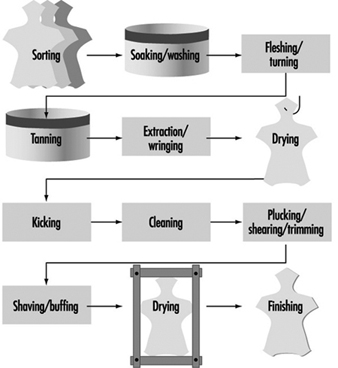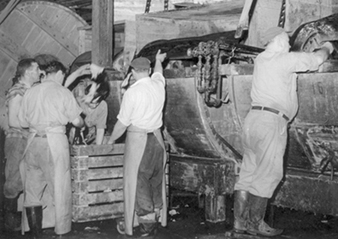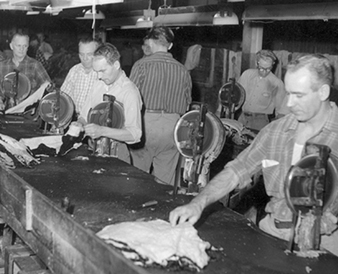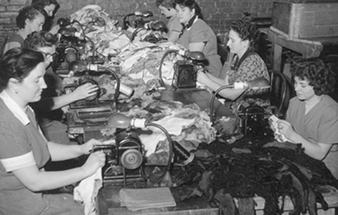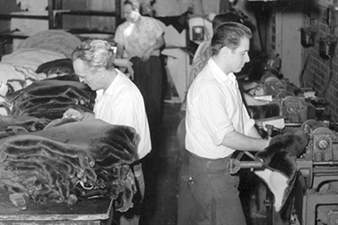Adapted from the article by the author that appeared in the 3rd edition of this Encyclopaedia. Acknowledgements to Gary Meisel and to Tom Cunningham of the United Food and Commercial Workers Union for reviewing and adapting this article
Rudimentary means of preserving furs have been used since very early times and are still practised in many parts of the world. Typically, after the pelt is scraped and cleaned by washing, the skin is impregnated with animal oil, which serves to preserve it and make it more pliable. The pelt may be beaten or chewed after the oil treatment in order to effect better impregnation by the oil.
In the modern fur industry, pelts are obtained from fur farmers, trappers or hunters. At this stage they have been stripped from the carcass, flesh and fatty deposits have been removed by scraping and the pelts have been stretched and air dried. The fur industry grades the pelts according to factors such as the general condition of the pelt, fur length, curl and patterning. The pelts go through a series of treatment steps, called fur dressing, to preserve them (see figure 1). The furs may also be dyed. Fur dressing and dyeing are done in batches, with the pelts usually being transferred from one step to another using hand carts.
Figure 1. Flow chart of fur dressing
Fur Dressing
First, the pelts are sorted, stamped with an identifying mark, and cut open using knives and snippers. They are then soaked in salt water in tubs or barrels for several hours to re-soften them (see figure 2). Rotating paddles are often used to help this soaking. Sometimes formic acid, lactic acid or sulphuric acid is used in the soaking step. The excess water is then removed in revolving drums.
Figure 2. Soaking department in a fur-processing works
Office du film du Quebec
Next, the underside of the pelt is drawn across razor-sharp round-knife fleshing machines by workers known as fleshers (figure 3). Hand turning (turning the pelt inside out) and trimming with knives is also done. This operation removes the loose connective tissue from the underside of the skin. The object is to remove, as far as possible, any tissue which is not involved in the attachment of the fur, thus producing the maximum degree of lightness and flexibility of the pelt.
Figure 3. Machine fleshing of lamb skins
Office du film du Quebec
The pelts are now ready for tanning and are soaked in alum solution in pits or tubs. As with soaking, paddles are used. The alum solution is usually acidified somewhat with hydrochloric or sulphuric acid. The alum treatment may be carried out in either an aqueous or an oil solution. Excess liquid is extracted and the pelts are dried in special drying rooms to set the skin collagen.
The tanned pelts are then treated with an oil solution in a kicking machine or similar type of machine to force the oil into the skin. They are then cleaned in rotating drums containing sawdust, which absorbs moisture and excess oil.
Pelts contain guard hairs as well as the softer fur fibres. The guard hairs are stiffer and longer than the fur fibres and, depending on the type of fur and the final product desired, these hairs may be either partially or totally removed by machine or by hand plucking. Some pelts also require shearing or trimming with knives (see figure 4).
Figure 4. Shearing operation on Canadian beaver pelts
Office du film du Quebec
Other steps can include shaving or “paring out” with round-knife fleshers, buffing with buffing machines, drying and finishing. The latter can include degreasing, stretching, cleaning, buffing, brushing and lusterizing with lacquers and resins.
Dyeing
Although dyeing of furs was at one time not looked upon favourably, it is now an accepted part of fur preparation and is practised extensively. This can be done at the same time as tanning or in a subsequent step. The usual procedure involves treatment of the pelts with a weak alkaline solution (e.g., sodium carbonate) to remove dirt and oil residues. The pelts are then soaked in a mordant solution (e.g., ferric sulphate), after which they are steeped in dye solution until the desired colour is obtained. They are then repeatedly rinsed and drum-dried with the aid of sawdust.
Many other chemicals may be used in dyeing, including ammonia, ammonium chloride, formaldehyde, hydrogen peroxide, lead acetate or nitrate, oxalic acid, sodium perborate,
p-phenylenediamine dyes, benzidine dyes and so forth.
Fur Garment Manufacture
Before being made into garments, pelts may be cut and “let out”. This involves making a series of closely spaced diagonal or V-shaped slits in the skin, after which the pelt is pulled in order either to lengthen or to broaden it as needed. The pelt is then re-sewn (see figure 5). This type of operation requires great skill and experience. The pelts are next thoroughly moistened and then laid out and tacked on a board according to a chalked-on pattern, left to dry and sewn together. Finally, lining and other finishing steps complete the garment.
Figure 5. Operators engaged in the machine sewing of skins
Office du film du Quebec
Hazards and Their Prevention
Accidents
Some of the machines used in fur processing present serious hazards unless sufficient guarding is maintained: in particular, all drums should be protected with an interlocking gate and the centrifuges used for extraction of moisture should be fitted with interlocking lids; fur clipping and fur cutting machines should be totally enclosed except for the feed and discharge openings.
Vats should be covered or effectively railed to prevent accidental immersion. Falls on wet and slippery floors can be largely prevented by maintenance of sound, impervious surfaces, well-drained and frequently cleaned. Dyeing vats should be surrounded by drainage channels. Accidents caused by hand tools can be reduced if the handles are well designed and the tools well maintained. In the fur manufacturing sector, sewing machines require similar protection to those used in the garment trade (e.g., guarding of driving mechanisms and of needles).
Health Hazards
The use by the fur industry of such a large proportion of pelts from animals bred in captivity has considerably reduced the likelihood of transmission of animal diseases to fur workers. Nevertheless, anthrax may occur in workers handling carcasses, skins, hides or hairs from infected animals; a vaccine may be administered to all likely to have contact. All concerned should be aware of the risk and trained to report any suspicious symptoms immediately.
Various chemicals used in the fur industry are potential skin irritants. These include alkalis, acids, alum, chromates, bleaching agents, oils, salt and the compounds involved in the dyeing process, which comprise various types of dyes as well as mordants.
Unpacking of bales which have been treated with dusting powder in their countries of origin, drumming, plucking, unhairing and shearing can all produce irritant dust. In dye houses and dye kitchens, where salts of lead, copper and chromium (and possibly carcinogenic dyes) are weighed and cooked, there is also a risk of ingestion of toxic dusts. Injurious vapours may arise from degreasing solvents and fumigating chemicals. There is also the possibility of development of contact sensitization (allergy) to some of these chemicals or to the dust from one or more of the types of fur being handled.
The main protection against the hazards of dust and vapours is the provision of local exhaust ventilation; good general ventilation is also necessary throughout the process. Good housekeeping is important to remove dust. Personal respiratory protective equipment may be necessary for short-term jobs or in addition to local exhaust at particularly dusty operations. Particular attention should be paid to potential confined space hazards in pits and vats used for soaking/washing, tanning and dyeing.
Protective clothing appropriate to the process is necessary at most stages of fur processing. Rubber hand protection, foot and leg protection and aprons are required for wet processes (e.g., at the dye and mordant vats) and as a protection against acids, alkalis and corrosive chemicals. Good sanitary and washing facilities, including showers, should be provided. Bleaches and strong alkali soaps should not be used for hand cleansing.
Ergonomic problems can result from manual lifting and moving of materials, especially pushing hand carts, and manual loading and unloading of pelts (particularly when wet). Automation of these processes can help solve these problems. Repetitive motions in fur garment manufacture are also a source of ergonomic problems.
Heat stress diseases can occur while working in the drying room. Preventive measures include adequate exhaust of hot air and supply of cool air, limiting exposure time, readily accessible drinking water and training in the recognition of heat stress symptoms and in first aid measures.
Noise can be a problem with many of the machines used, especially in drums and combing, shearing and lusterizing machines.
Pre-placement medical examination can assist in the prevention of dermatitis by proper placement of employees with a history of sensitivity. Medical supervision is desirable; well maintained first-aid provisions in the charge of trained personnel are essential. Strict attention to hygiene, ventilation and temperature are necessary in the many small workrooms in which much of the making of fur garments is done.

